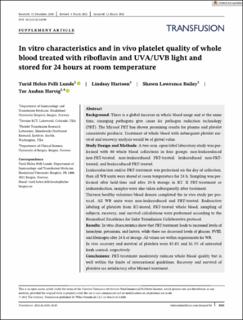| dc.description.abstract | Background
There is a global increase in whole blood usage and at the same time, emerging pathogens give cause for pathogen reduction technology (PRT). The Mirasol PRT has shown promising results for plasma and platelet concentrate products. Treatment of whole blood with subsequent platelet survival and recovery analysis would be of global value.
Study Design and Methods
A two-arm, open-label laboratory study was performed with 40 whole blood collections in four groups: non-leukoreduced non-PRT-treated, non-leukoreduced PRT-treated, leukoreduced non-PRT-treated, and leukoreduced PRT-treated.
Leukoreduction and/or PRT-treatment was performed on the day of collection, then all WB units were stored at room temperature for 24 h. Sampling was performed after hold-time and after 24-h storage in RT. If PRT-treatment or leukoreduction, samples were also taken subsequently after treatment.
Thirteen healthy volunteer blood donors completed the in vivo study per protocol. All WB units were non-leukoreduced and PRT-treated. Radioactive labeling of platelets from RT-stored, PRT-treated whole blood, sampling of subjects, recovery, and survival calculations were performed according to the Biomedical Excellence for Safer Transfusion Collaborative protocol.
Results
In vitro characteristics show that PRT-treatment leads to increased levels of hemolysis, potassium, and lactate, while there are decreased levels of glucose, FVIII, and fibrinogen after 24 h of storage. All values are within requirements for WB.
In vivo recovery and survival of platelets were 85.4% and 81.3% of untreated fresh control, respectively.
Conclusions
PRT-treatment moderately reduces whole blood quality but is well within the limits of international guidelines. Recovery and survival of platelets are satisfactory after Mirasol treatment. | en_US |

